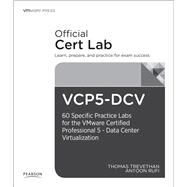There's no substitute for hands-on experience, especially if you're preparing for VMware's new VCP5-DCV certification exam. VCP5-DCV Lab Booklet reinforces your other study, classroom, or work experience with 60 practice labs fully aligned to both VMware's newest exam blueprint and VMware Press's Official Cert Guide. The only VCP5 lab book on the market, it covers dozens of real-world applications, including:
- Installing and configuring ESXi, vCenter Server, and the vSphere Client/vSphere Web Client
- Upgrading an ESXi Host using vCenter Update Manager
- Managing services and permissions
- Working with vSphere Distributed Switches
- Configuring load balancing, failover, VLANs/PVLANs, and traffic shaping
- Working with shares, hardware and software initiators, and datastores
- Configuring and deploying a Guest OS into a new VM
- Managing virtual disks and disk shares
- Installing, upgrading, or updating VMware tools
- Configuring and modifying virtual CPUs, Memory Resources, and virtual NIC adapters Creating, cloning, exporting, and adding objects to vApps
- Creating, cloning, templating, and deploying VMs
- Configuring VM options and power settings
- Creating, configuring, monitoring, and deleting clusters
- Configuring VMware fault tolerance networking and resource pools
- Migrating VMs with vMotion/Storage vMotion
- Creating, deleting, and consolidating VM snapshots
- Creating backups of VMware Data Protection
- Monitoring ESXi system health and exporting diagnostic information
- Using vCenter logging and alarms
- And much more








